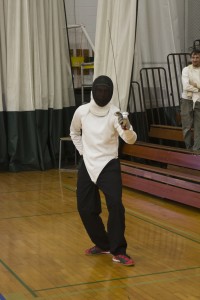Students at STLCC are able to take fencing class for PE credit
By: Aaron McCall
-Staff Writer-

The age-old saying of ‘en-guard’ lets students know a duel is about to happen during fencing class.
Eyesight and reflexes are two keys to being an auspicious fencer. Aside from the tactics and skills needed to prosper in the sport, there is the respect people who participate in the sport have for each other.
“There is a certain mystique about fencing because a lot of people do not know anything about it,” STLCC-Meramec fencing instructor Bill McDevitt said.
Fencing is one of many physical education classes offered at the Meramec campus. The course spans across eight weeks and there are 16 class periods. There are three different weapons that can be used during a fencing duel: the eppe, the saber and the foil. According to McDevitt, one of the things that holds down fencing is the investment involved with it.
“You need a mask to protect your face and eyes, a heavy canvas jacket to protect your torso and you need a glove and a weapon. We are very fortunate here at Meramec. For anyone who takes the physical education class we have all the fencing equipment available,” McDevitt said.
McDevitt, who fenced competitively for four years at the University of Illinois under the instruction of Max Garret, has been teaching fencing at Meramec for eight years. McDevitt credits his former Illini coach for his knowledge of the sport.
“All my knowledge of fencing I gained at the University of Illinois. I had a fantastic coach,” McDevitt said. “One thing I would say I want the world to know about fencing is that it is a gentlemanly sport.”
The “gentlemanly sport” that McDevitt refers to, stems from the intellectual thought process that comes with every move made within a duel.
“Fencing is a sport of finesse,” McDevitt said. “There is a joke out there that fencers do it with finesse and there is a lot of truth to it. When you first start out, fencing is 75 percent physical and 25 percent mental. As you progress it becomes 75 percent mental and 25 percent physical.”
Fencing may be unique in its own right, but according to McDevitt, a lot of the skills that are used in the sport of fencing can apply to everyday life. Attributes like discipline, patience and the ability to think before you act are lessons learned in the world of fencing.
“The victor is the one who tried, versus the one that sits back and never did anything,” McDevitt said. “There is a lot of truth to that. Fencing is not one of those everyday sports, so the people who are taking my class, my hats off to them because they are trying something new.”











